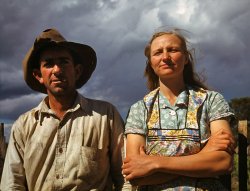
MAY CONTAIN NUTS

Search Shorpy
SHORPY ART

Framed or unframed, desk size to sofa size, printed by us in Arizona and Alabama since 2007. Explore now.
Join and Share
Ad-Free Shorpy
Shorpy is funded by you. Patreon contributors get an ad-free experience.
Learn more.

Recent comments
- If You’re Like Me, Never
- U.S.A.
- S&P
- 1940 Zenith radio model 6G601
- Quality goes in before the name goes on!
- Snazzy skirt
- Carbon Arc Lamps
- Illuminate us
- I remember it well
- I can't prove it
- Complicated then, forgotten now
- Bryan-Stevenson
- Skinny is as skinny does
- How do you rest in peace
- Riding the footboards
- Alas, hidden from view
- Baldwin Diesels
- Exclusive pump
- Bananas, Oysters and Smokey Joe
- Details, Details
- What's that building to the left of the tower?
- Coal Barges
- Bromo-Seltzer
- Inner harbor
- The Basin
- What a headache!
- Giant stepladder?
- Yeah, it was cold
- Love those coats
- Link & Pin Days Remnant
Member Photos
The Shorpy
Print Emporium
Print Emporium
Search Shorpy
Search results -- 30 results per page
- Utah Copper Co.: 1942
- ... despite lots of Googling. I suspect it is in Arizona or New Mexico.
Thanks to shooting through a badly-etched window, the scene was ... Posted by Dave - 08/30/2012 - 4:47pm -
![Utah Copper Co.: 1942 November 1942. Bingham Canyon, Utah. "Open-pit workings of the Utah Copper Company. This is the Carr Fork side, from which the company obtains huge amounts of ore. The Carr Fork bridge and main shops appear in the foreground." 4x5 Kodachrome transparency by Andreas Feininger. View full size.
The Second Time AroundI thought I'd seen this mine featured here before now.
https://www.shorpy.com/node/4463
Incredible epic pictureThe detail is amazing.
WowEpic proportions.
In the Gift ShoppeYou should add a "jigsaw puzzle" option to the print sales business; this photo in particular would make a wonderful jigsaw puzzle.
Ore TrainThat engine looks like a scaled down knockoff of a GG-1. Anyone know what it is?
Massive Mystery MineWhile on a trip to the west coast about 30 years ago, I snapped this shot of an open pit mine, name unknown. I've never located it despite lots of Googling. I suspect it is in Arizona or New Mexico.
Thanks to shooting through a badly-etched window, the scene was given a somewhat psychedelic colorized effect.
[A number of commenters ID this as the Sacaton (Casa Grande) copper mine south of Phoenix. - Dave]
Thanks to everyone for solving my mystery after all these years!
Electric locomotivesThe electric locomotive in this scene is known as a "steeplecab" and was a common type used in interurban and industrial freight service in the teens and '20s. The Bingham Canyon mine used many of these over the years and several have been preserved at museums. Here's one: http://www.davesrailpix.com/wrm/htm/wrm045.htm
Little Engine That DidThe engine pulling the ore train is a steeple-cab with an articulated frame that has four wheels (two axles) on each part. These were very heavy locomotives and I believe that they built for this application only.
Coincidently, the towers holding the overhead (trolley) wire could be moved could be moved when the track arrangement was changed to access the changing ore deposits.
General ElectricsI believe the engine in the foreground is a (General Electric) GE 90-ton electric. The Bingham Utah Copper Mine received four of these engines in February 1942 and were lettered for Kennecott Copper Corporation. They were numbered KCC 761,KCC 762,KCC 763,and KCC 764.
Where do we go?!About 100 feet in front of the ore train are 3 men and a push cart. I assumed the locomotive was pulling but for these guys' sakes I hope it's pushing!
The EngineThe locomotive is a fairly standard Steeplecab design. The design - two powered axles on each truck - was pretty ubiquitous on electric lines worldwide.
(The Gallery, Kodachromes, Andreas Feininger, Mining)](https://www.shorpy.com/files/images/1a34852u.thumbnail.jpg)
- La Casa Enchilada: 1940
- ... June 1940. "Detail of front of store building. Mogollon, New Mexico." Photo by Russell Lee for the Farm Security Administration. View ... any good.
Travel book release Titled "Mogollon, New Mexico, on $1.40 per day." The bench may not look too sturdy and the ... Posted by Dave - 08/21/2018 - 11:31am -
![La Casa Enchilada: 1940 June 1940. "Detail of front of store building. Mogollon, New Mexico." Photo by Russell Lee for the Farm Security Administration. View full size.
The Conversation Just After"C'mon in for a spell", the man with the dirty apron said, waving around a glass with some tired foam on it.
"Nah, can't. Got work to do." said the photographer, feeling he'd been caught. "Government work. It's important. Might be famous someday."
"What do you think I'm sayin, bud? I'm makin some more signs here and I need some help. I need a spell checker."
[And that's when the photographer told him about a job opening in Montana. - Dave]
Just askin'Do you get an enchilada or two if you board there? Looking at the prices, it might be a good deal if they're any good.
Travel book releaseTitled "Mogollon, New Mexico, on $1.40 per day." The bench may not look too sturdy and the curtains double as dish towels (or vice versa) but where else can you take a vacation including food and lodging for that price?
I wonder... if irregular boarders got a discount.
Grill MarksGiven that bench is made out of straps of sheet metal, it's a wonder anyone ever actually sat on it.
An interesting little town!... but the road to get there is not for the faint-hearted!
It Still StandsIf you go to street view, it's known as the Old Kelly Store. It's easy to find in such a small area. It's been patched oa bit over time.
(The Gallery, Eateries & Bars, Russell Lee, Small Towns)](https://www.shorpy.com/files/images/SHORPY-8b25544a.thumbnail.jpg)
- Genoa Jalopy: 1940
- ... film "Charley Varrick", as the fictional Tres Cruces, New Mexico. The exterior of the Genoa Courthouse Museum (just down the street ... played the "Tres Cruces Western Fidelity Bank of New Mexico".
And yes, Genoa is the oldest permanent settlement in Nevada. ... Posted by Dave - 10/12/2017 - 8:39am -
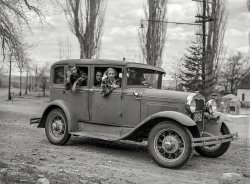
- Suburban Buick: 1957
- ... it's California. The plates are red on yellow. Could be New Mexico? Great find.
[The red fringing is a scanning artifact. The ... Posted by Vintagetvs - 01/12/2017 - 8:44pm -
![Suburban Buick: 1957 A 1957 Buick, houses in colors not seen anymore, and lots of antennas. A 35mm Kodachrome slide I found somewhere. View full size.
New FrontierI can just hear Donald Fagen's song New Frontier playing when I look at this Kodachrome slide.
All made of ticky-tackyThere's a pink one, and a green one...
Factory Air-Conditioningis an option on this Special by the presence of the stainless steel outlets in the middle of the dash pad--also new was an enlarged 364 V-8 with a slightly reduced 250 horsepower in this base, but still beautifully trimmed out, model.
Conical antennasLook like Florida houses. Those are conical TV antennas. Low gain, wide band inexpensive antennas very popular in the '50s before UHF stations became common. As a kid I made money putting those up for neighbors.
TV forecast: snow 24/7Nothing to miss about the reception from those antennas.
MatchThe top of the car and the house
Beautiful Three toned BuickCar color matches the house yet. Unbelievable.
A Buick FamilyIt's like the '54 we had when I was 6. We drove it across country from Baltimore in 1957 to our new home in California. Later traded it in on a 1960 Olds wagon.
http://www.1960oldsmobile.com/wp-content/gallery/featured-member-jason-n...
Both great cars for a kid to bounce around in!
Looks Like CAThe lack of gutters and the orange license plate looks like CA (Black plates were introduced around 1963.) Considering GM's marketing strategy of moving from Chevrolet to Pontiac to Oldsmobile and ultimately to Cadillac, this house looks too modest for a Buick driver. Maybe the landlord has stopped by to collect the rent.
I was 15And I could name any car from any distance.
Little Pink Houses... and Buicks, for you and me.
Gold PlatedI don't think it's California. The plates are red on yellow. Could be New Mexico? Great find.
[The red fringing is a scanning artifact. The plates are black on yellow. -tterrace]
Those old style antennasIt's interesting to see the old stacked conical and dipole rooftop TV antennas, instead of the later horizontal log-periodic ones. And I like the wood on the garage door, and the front of the house near the front door. Redwood?
The Buick looks like a Special two-door hardtop, and the colors look like Shell Beige (Code P) over Dover White (Code C). Hat tip: Paintref.com.
House ColorsSorry, but if you think houses aren't painted sherbet pink and green anymore, you haven't been to San Francisco.
Tim Burton's inspirationThis scene looks like it's right out of Edward Scissorhands.
(ShorpyBlog, Member Gallery)](https://www.shorpy.com/files/images/buickpinkhouseantennas.thumbnail.jpg)
- Westbound Freight: 1943
- ... 1943. Westbound Santa Fe freight on a siding at Ricardo, New Mexico, waiting for the eastbound train to pass. View full size. 4x5 ... Posted by Dave - 08/10/2012 - 4:15pm -
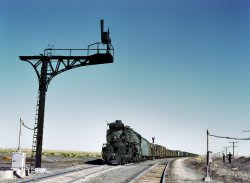
- Sugar and Spice: 1943
- February 1943. "Moreno Valley, New Mexico. Mary Mutz making an apple pie on the Mutz ranch." John Collier for ... very popular. Seems fitting for it to be found in a New Mexico household.
(The Gallery, John Collier, Kitchens etc.) ... Posted by Dave - 03/11/2014 - 2:10pm -
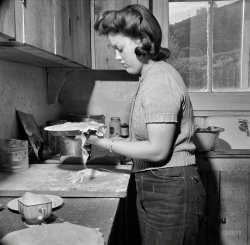
- Brakeman Capsey: 1943
- March 1943. "Acomita, New Mexico. Brakeman R.E. Capsey repacking a journal box of a special car as ... Topeka & Santa Fe Railroad between Belen and Gallup, New Mexico, waits on a siding." Medium-format negative by Jack Delano for the ... Posted by Dave - 02/11/2014 - 11:29am -
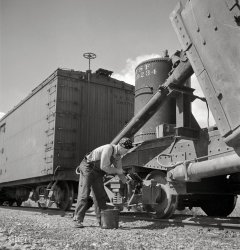
- Slow Train Coming: 1943
- March 1943. "Gallup, New Mexico. A train on the Atchison, Topeka & Santa Fe between Belen and Gallup, New Mexico." Medium-format negative by Jack Delano for the Office of War ... Posted by Dave - 10/02/2015 - 11:15am -
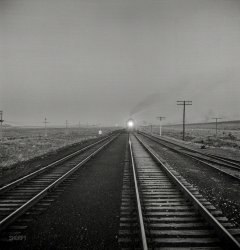
- Mint Bar: 1941
- ... to meet over a game of “8 Ball” in a little bar in New Mexico four decades to the month from this photo’s date.
We played a ... Posted by Dave - 06/15/2015 - 1:26pm -
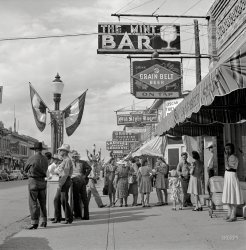
- Shady Rest: 1940
- ... July 1940. "Street scene at the fiesta in Santa Fe, New Mexico." Our third look at the festive goings-on here, and we'll let ... Posted by Dave - 09/20/2014 - 8:48am -
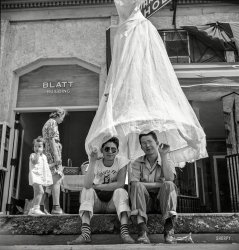
- Luna Park: 1913
- ... flag. It was adopted on July 4, 1912 after Arizona and New Mexico were admitted to the union.
[It shows 38, not 45. But it has ... Posted by Dave - 06/25/2009 - 10:01am -
![Luna Park: 1913 May 19, 1913. Promenaders at Luna Park, "The Heart of Coney Island." 5x7 glass negative, George Grantham Bain Collection. View full size.
[+] Not My 1913If this picture was taken in 1913, I'll eat my hat. My bowler hat. Or my wife's Merry Widow hat. Nobody dressed like this in 1913. Not a hobble skirt in sight. This photo is from 1908-1910 and no later. Trust me, I know.
[The date is written right on the glass. Plus the flags have 48 stars. Bon appetit. - Dave]
Is it my imagination……or is that upper left flag a 45-star flag? Unless this was some sort of old flag display (which it doesn't really appear to be), they should have been flying a 48-star flag. It was adopted on July 4, 1912 after Arizona and New Mexico were admitted to the union.
[It shows 38, not 45. But it has 48. Six staggered rows of eight stars each. One corner is out of the frame, so we can't see them all. If you look at the flag on the right, you will see it also has 48 stars. Eight stars in the top row, eight stars in the second row, etc. - Dave]
[+] What Goes On Here?There is a man, just right of the very center of this photo who appears to be aiming a machine gun at a hole in the ground. It looks like a group of people have gathered around to watch. His white pants would indicate that he is a custodian. Hmmm.
[Diabolical. And ingenious. His machine gun is cunningly disguised as a board. - Dave]
[+] I was going by……the staggered rows, not just the stars in the frame of the photo. I guess a 48-star flag was still new enough that perhaps the maker of it hadn't seen the official non-staggered 6-rows-of-8 version.
[Prior to 1916 there was no official version. See comment above. - Dave]
48 star flagPrior to 1916 there was no official design, says the flag website nava.org:
Q: I have two different 48 state flags. One has 48 staggered stars and the other has eight equal rows across with six rows down. Were there two different 48 state flags ever made? - Marla
A: Prior to 1916, there were no official specifications for US flags. Indeed these two variants show up right from the beginning of the 48 star flag in 1912. After 1916, pretty much everyone switched to the even rows with the stars one over the other like the second one you mention. 48 star flags with staggered rows are somewhat rare and are early (1912-1916 or thereabouts).
Beautiful Coney...and it still looks like that to this day.
(The Gallery, Coney Island, G.G. Bain, Sports)](https://www.shorpy.com/files/images/09490u.thumbnail.jpg)
- Pie Town Homesteaders: 1940
- September 1940. Jack Whinery, Pie Town, New Mexico, homesteader, with his wife and the youngest of his five children in ... Posted by Dave - 08/30/2012 - 12:02pm -
![Pie Town Homesteaders: 1940 September 1940. Jack Whinery, Pie Town, New Mexico, homesteader, with his wife and the youngest of his five children in their dirt-floor dugout home. Whinery homesteaded with no cash less than a year ago and does not have much equipment; consequently he and his family farm the slow, hard way, by hand. Main window of their dugout was made from the windshield of the worn-out car which brought this family to Pie Town from West Texas. 4x5 Kodachrome transparency by Russell Lee, Farm Security Administration. View full size.
More on Pie TownFrom Smithsonian.
WitnessKodachrome has such a richness and vibrancy, eh? This photo makes it seem like we're standing at the photographer's right shoulder, looking on, feeling the Whinery's discomfort in what must have been a very small space. Sixty-seven years on, and we're right there. Thanks Mr. Lee.
Denny Gill
Chugiak, Alaska
Love the colorEvery time I look at one of these photos from the 40s, with that deep, rich color, I think we must have entered a color "dark age" of sorts in the 60s, 70s and 80s...
Loudon The Second?Something about this guy's face reminds me of Loudon Wainwright III
DignityA sense of dignity is shown by this family. I think today's news media would tell them to "look defeated/miserable" before taking the photo.
Modern media?If a freelance photographer went to take pictures of a family in these circumstances today he wouldn't likely be able to sell the photos, because no newspaper would be interested in publishing them. If he had a good shot of Lindsay Lohan, he could make $400,000 at bare minimum.
So why again would he waste his time taking pictures of these people?
[Russell Lee wasn't freelance. He was employed by the Farm Security Administration. - Dave]
Hellooooooo handsome!I'm getting a time machine and moving to Pie Town.
Going back to Pie TownI Google Mapped Pie Town and zoomed in on the streets. You can also "stand" on the hiway there as well. You can also go to Pietown's own website and see a few photos.
Would like to know where his dugout house was and what happened to it.
My brother said something profound about all these pictures. He's only in his forties, but he said, "I wasn't even alive and I miss this stuff."
I think of these photos as true Americans. I miss it too, and I want it back!
>>--------->
(The Gallery, Kodachromes, Pie Town, Rural America, Russell Lee)](https://www.shorpy.com/files/images/1a34170u.thumbnail.jpg)
- Bunk Car: 1943
- March 1943. "Iden, New Mexico. One of the bunk cars for section workers of a train on the ... Posted by Dave - 07/02/2009 - 12:57pm -
![Bunk Car: 1943 March 1943. "Iden, New Mexico. One of the bunk cars for section workers of a train on the Atchison, Topeka and Santa Fe Railroad between Clovis and Vaughn." Medium-format nitrate negative by Jack Delano. View full size.
This ain't the Army, SIR.Was hoping that thingy was an air freshener which this room probably needs. No bouncing quarters off THOSE beds! Bet that spit bucket serves two purposes, if'n you know what I mean.
DisheveledIt appears to be 8:30 a.m. and the men are off to work. I note the ash grate door is open on the stove and a spit bucket by the bed. Can someone identify the item on the wall in the corner at left, near the lower bunk?
[A kerosene lamp. - Dave]
What? No HDTV?All it's missing is a La-Z-Boy, remote control and a bowl of popcorn.
Sleeps FourThe cleaning lady hasn't been here for awhile ... and WHERE'S THE TV??
(That's what my grandson asked)
On ScheduleDo I spy a box of prunes?
(Rail)road tripObviously, I regret not having had an RV growing up -- this looks fun. More room than an Amtrak, anyway.
Looks Like HomeMy father was born in a car like this, though probably a little neater and a bit earlier, 1926. His father was a bridge and structure painter for the Santa Fe. Father, Mother and newborn lived aboard the train and traveled the Southwest, painting as they went. The "bucket" near the bed may have been from paint or solvent. There was also a custom in the day of putting cans of kerosene under bedposts to prevent bugs from getting to the beds, perhaps this sleeper was saving up for that.
[Or it might be full of sand. - Dave]
It needsa woman's touch. Some curtains, a broom, a few pictures, vase of flowers -- all the homey stuff.
Roughing it in 1969I lived on one of these the summer of 1969 while a member of a CB&Q line gang in Wisconsin and Illinois. We had electricity (when parked close enough to a power source), but no toilet and no hot water.
(The Gallery, Jack Delano, Railroads)](https://www.shorpy.com/files/images/8d27011u.thumbnail.jpg)
- Pie Town Parley: 1940
- ... October 1940. "Farm family after evening meal. Pie Town, New Mexico." Medium format acetate negative by Russell Lee for the Farm ... Posted by Dave - 06/13/2020 - 12:40pm -
![Pie Town Parley: 1940 October 1940. "Farm family after evening meal. Pie Town, New Mexico." Medium format acetate negative by Russell Lee for the Farm Security Administration. View full size.
Night Time is the Best TimeI love the atmosphere that the photographer achieved with the balance between light and dark, and the interactions between the people. Well done!
It doesn't get any betterIt's just a beautiful photograph and a beautiful moment, especially the engagement between the two women.
Where the men are laconicMy mother comes from a ranching and farming family a little south of Pie Town. I can say with certainty that the aforementioned engagement between the women is partly because those two men didn't say more than six sentences each throughout dinner. And the words "Fine", "Yes", and "No" constitute sentences.
Double word scoreEvery single photo of a table lit by a kerosene lamp reminds me of my dad's story of playing Scrabble by kerosene lamp during Hurricane Carla in 1961. It's a story I've heard in various forms for as long as I've been playing Scrabble, and I'm sure the final version will be told in the memoir he says he's writing. Oh, but unlike the residents of Pie Town, they had electricity when there wasn't a hurricane, right? Well, yeah. He also has childhood memories of his grandmother's place in West Texas, before the REA.
And then there's the story of the stray cow.
Have to sayI can't think of a better photograph on this site. Old friends relaxing after a long day. Wow!
Questions remainAre the older couple parents of the young woman or the man? Whose house are they at or do they share a domicile? Is this a nightly affair or is it weekly? An aspiring writer could run far with this image.
That map tho.I wish I could see a detailed version!
Gogh's "Potato eaters"Real life reenactment, if ever was the one.
Keeping John D. Rockefeller in businessThe table lamp looks to be a Rayo round-wick model with an Argand burner. Rayos were made by Bradley & Hubbard and marketed by Standard Oil; there is a story that a free Rayo lamp came with a purchase of 15 gallons or more of Standard kerosene. Rayos have a rep among collectors as fuel hogs, which quite possibly is why Standard Oil got involved with them in the first place. They became much less popular after 1907, when the Aladdin lamp combined an Argand burner with a Welsbach rare-earth mantle to produce a better and more economical light.
Amazing imageI don't often wonder about technical aspects in most photos, but I would love to know the details on how Lee captured and processed this image so perfectly under these conditions.
[A lot of the processing was by Photoshop, a few hours ago. - Dave]
Reminds me of Hopper's "Nighthawks"I'm aware of the power of the image having neutralized any distracting surroundings by darkness so that you can't help but let the faces tell the story. I'm thinking of Malcolm Gladwell's book, Blink, and how universal are the expressions of our faces. This image is captivating me.
"A lot of the processing was by Photoshop"Photoshop truly is amazing. I looked up this photo on the LoC website and saw just how dark and low in detail it appears from the original negative. The astonishing thing is that all the detail actually was recorded; it's just that film and processing weren't up to recovering it. Dave's restoration augments Lee's talent.
Much as I dream of the past, today has its wonders.
[Any "recovering" of detail would have happened in the darkroom when the negative was printed. - Dave]
Agreed: burning, dodging and other tricks were routine in any darkroom. But even the most artful enlarger artisan would be very hard pressed to ever create a finished print to rival what we can do in Photoshop in seconds.
PainterlyRembrandt lighting a couple of centuries later.
(The Gallery, Kitchens etc., Pie Town, Rural America, Russell Lee)](https://www.shorpy.com/files/images/SHORPY-8b38165a.thumbnail.jpg)
- New Jersey Zinc: 1911
- ... Earth A subsidiary of New Jersey Zinc, Empire Zinc of New Mexico, was the subject of the 1954 movie "Salt of the Earth," based on ... Posted by Dave - 06/21/2016 - 10:54am -
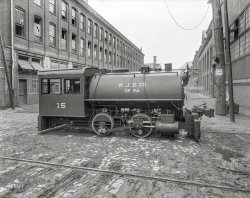
- The White Family: 1913
- ... and photography instructor for the Manhattan Project in New Mexico and in the Pacific, and later founded the important Photography ... Posted by Dave - 07/17/2020 - 3:56pm -
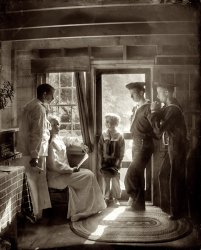
- Pie Town: 1940
- ... 1940. "General Merchandise store, Main Street, Pie Town, New Mexico." View full size. 4x5 Kodachrome transparency by Russell Lee.
... Posted by Dave - 08/01/2012 - 1:32pm -
![Pie Town: 1940 October 1940. "General Merchandise store, Main Street, Pie Town, New Mexico." View full size. 4x5 Kodachrome transparency by Russell Lee.
amusing...Only three shops on Main Street and one is a taxidermist.
Pie townWas the reason Pie Town had dugout buildings because of its location in the hot desert area of NM? Where was Pie town located exactly in NM and does it exist today?
[Can you use Google? Wikipedia? Pie Town is up around 7000 feet elevation. It's not in the "hot desert." Pie Town website. - Dave]
Pie TownYes, I can use Google & Wikipedia, thought it was easier to ask than have to look up. Thanks for the info anyway. Oh and thanks very much in creating a fantastic web site that really tells the story of our country's developement, advancements, hardships and it's people. This web site would be a great asset in history classes for all grades, wish it was around when I went to school.
Pie TownPie Town still exists and looks much the same today.
located in west central N Mex at elevation of 6200 ft.
old cowboy camp in the 1870s that sold pies from homesteader wife. high desert country with mild summers and some snow in winters.
Pie Town DugoutsThe reason for using dugout buildings might be for insulation in the winter. No draft in the corners, see.
Dugout buildings are veryDugout buildings are very common in colder places. Almost all the Central European immigrants who homesteaded the Canadian Prairie Provinces spent their first year or two in dugout buildings.
As said before, they eliminate drafts (and more importantly they insulate against the cold!), but you also need much less wood to build a dugout building. Some had sod roofs and upper walls, and the lower walls were nothing but dirt. It was basically free housing, which was essential because homesteading legally required the owner to live on the land for a certain number of years.
(The Gallery, Kodachromes, Pie Town, Russell Lee, Stores & Markets)](https://www.shorpy.com/files/images/1a34163u.thumbnail.jpg)
- The Texaco Troubadour: 1940
- June 1940. Pie Town, New Mexico. "Farm boy playing guitar in front of the filling station and ... Posted by Dave - 08/14/2012 - 5:04am -
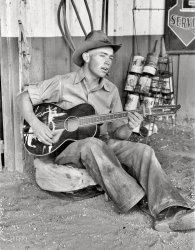
- Down to Belen: 1943
- March 1943. "Belen, New Mexico. Going across the Rio Grande River Valley on the Atchison, Topeka & Santa Fe R.R. between Vaughn and Belen, New Mexico. There is a drop of over 1600 feet in elevation." Photo by Jack ... Posted by Dave - 10/11/2013 - 4:04pm -
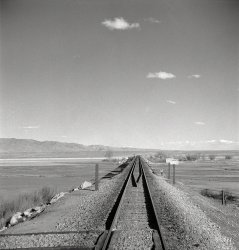
- Death Won Here: 1940
- ... "Marker of accident on the highway in Bernalillo County, New Mexico." Photo by Russell Lee for the Farm Security Administration. View ... Posted by Dave - 08/15/2018 - 11:09am -
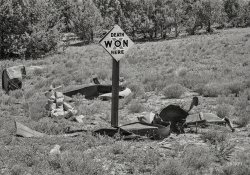
- Pie Town Picnic: 1940
- ... Sept. 1940. "Serving the barbecue dinner at the Pie Town, New Mexico Fair. Pie Town is a community settled by about 200 migrant Texas and ... Posted by Dave - 09/07/2011 - 4:02pm -
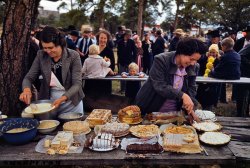
- Heck Ranch: 1943
- February 1943. Moreno Valley, New Mexico. "William Heck ranch. Mrs. Heck getting supper." Photo by John ... Posted by Dave - 07/07/2014 - 5:05pm -
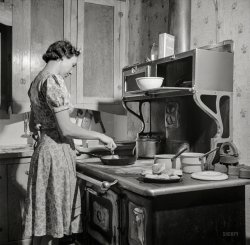
- Silver City Buick: 1940
- ... 1940. "Insignias on tourist's car seen in Silver City, New Mexico." View full size. 35mm nitrate negative by Russell Lee for the ... Posted by Dave - 01/29/2008 - 11:16am -
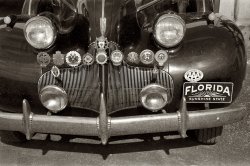
- Cafe Society: 1943
- ... 'Killed'." From photos taken in and around Albuquerque, New Mexico, by John Collier for the OWI. View full size.
Bar looks ... Posted by Dave - 08/13/2014 - 6:56pm -
![Cafe Society: 1943 February 1943. "This image in a jacket marked 'Killed'." From photos taken in and around Albuquerque, New Mexico, by John Collier for the OWI. View full size.
Bar looks pretty well stocked.Might be 1943, but no shortage of beer and peanuts.
GodlessThe pledge of allegiance, before "under God" was added, hangs on the wall.
One Bourbon, One Scotch, One BeerNow that's what I call a bar. I bet it's heaving on a Friday night.
C'mon, Burquenos!Someone in my favorite city must recognize this place. It's time for Shorpy sleuths to leap into action. First clue: If the back wall is right, it's "Cafe [something]."
My kind of jointNo foo-foo drinks with straws there.
No martinis made with apple flavoured vodka either.
Sippers vs. SluggersYou can tell how a fellow drinks his beer by observing the foam rings left inside the glass every time he takes a drink. A sipper nurses his beverage, savoring the amber current flowing through his mind. The guy with the glasses facing the camera, center frame, is a sipper. If you zoom in you can plainly see three, maybe four foam lines closely spaced with a third of his glass empty. Perhaps he's short on cash and wanting to prolong his evening at the bar before returning home to the missus. A sipper sacrifices the crisp pop of a whole glass of cold beer on the belly and brain for the lingering pleasure of standing at the bar in the company of friends and neighbors
The gentleman looking straight at the camera with his cap pushed back is a slugger. Notice how his glass is also about a third sailboat fuel. One thick foam line tilted ever so slightly to the rim indicates he drained a third of his beer in two big gulps. Ahhh! Now that's refreshing!
Ol' Goober employs both tactics -- slug one, then sip one, slug one, sip one ... lather, rinse, repeat.
OverheadThe light fixtures are a schoolhouse pendant.
An observationDoggone, but that Gooberpea is an entertaining (and accomplished) writer!
Re: Sippers vs. SluggersWonderful analysis of the beer glasses. One of my all-time favorite Shorpy comments. Well done, Gooberpea! Best line: "A sipper nurses his beverage, savoring the amber current flowing through his mind." Close second: "A sipper sacrifices the crisp pop of a whole glass of cold beer on the belly and brain for the lingering pleasure of standing at the bar in the company of friends and neighbors." Pure poetry.
Santa Fe RR?The guy looking into the camera appears to wear a railroad cap. I wonder if this is near the Santa Fe yard off Central Ave.?
(The Gallery, Eateries & Bars, John Collier)](https://www.shorpy.com/files/images/SHORPY-8d26247u.thumbnail.jpg)
- Professor Turtle: 1925
- ... Underlying Upper Cretaceous Formations of San Juan County, New Mexico, [1919].
Washington Post, September 16, 1924.
... … An exhibit of turtles, which Dr. Reeside found in New Mexico, is on display at the institution.
Size matters Gonna need ... Posted by Dave - 11/15/2012 - 6:22am -
![Professor Turtle: 1925 September 4, 1925. "Prof. Chas. W. Gilmore, Smithsonian curator, with fossil turtle." National Photo Company Collection glass negative. View full size.
Fossil Turtle ExpertAnother photo of the professor and fossils at Dinosaur: 1924. Charles Whitney Gilmore wrote numerous papers and monographs on the subject including Description of Two New Species of Fossil Turtles, From the Lance Formation of Wyoming, [1916], and Reptilian Faunas of the Torrejon, Puerco, and Underlying Upper Cretaceous Formations of San Juan County, New Mexico, [1919].
Washington Post, September 16, 1924.
Fossils believed to be those of a hyanodon, a flesh eating mammal of the Oligocene period were received yesterday at the Smithsonian by Charles W. Gilmore, curator of vertebrate paleontology. … An exhibit of turtles, which Dr. Reeside found in New Mexico, is on display at the institution.
Size mattersGonna need a bigger caliper.
(The Gallery, D.C.)](https://www.shorpy.com/files/images/SHORPY_14428u.thumbnail.jpg)
- Family Truckster: 1937
- ... drought refugee families on the highway near Lordsburg, New Mexico, going to Roswell to chop cotton." Photo by Dorothea Lange for the ... Posted by Dave - 06/24/2014 - 9:11am -
![Family Truckster: 1937 May 1937. "One of three related Oklahoma drought refugee families on the highway near Lordsburg, New Mexico, going to Roswell to chop cotton." Photo by Dorothea Lange for the Resettlement Administration. View full size.
Homestead HeadgearTwo things jumped right out at me. The Texas license plate with the word "Farm" on it. Might it be that the state charged the farmer or the farm workers less than a regular tag or that juveniles could drive them on the property?
The other is that ten-gallon hat. I never realized that people, other than the actors in the 1930s cowboy films, wore them.
Hat's OkayBoys wore all kinds of interesting hats in the 1930s. Some of the male characters in the OUR GANG films wore leather aviator helmets with goggles, cowboy hats and beanies, kind of like a baseball cap without a bill. But the migrant farm workers in the picture really needed their big-brimmed hats for protection from the blazing sunshine of the fields.
That Hoot Gibson lookFor a true cowperson, the hat is always the last thing to go during hard times.
All God's children got shoesWell, not all of them. The people in this picture resemble the parched, weather-beaten landscape shown in the background, stripped and hanging on for dear life, barely alive, struggling for a shred of hope that things will get better. These 1930's dust bowl photos do remind us not to feel sorry for ourselves. Even the poorest among us today are living a luxurious existence compared to these down-trodden families.
Texas Farm PlatesIntroduced in 1934 with discount registration, still used today. Vehicle is supposed to be used off the farm only for "farm business." When I was in the Air Force in Texas in the 1960s many of the civil servants had farm plates on their pickups and a permanent hay bale or such in the back to prove "farm business" to any overeager State Trooper. This poor family's "farm business" has taken them a looong way from home.
In perspectiveThis picture has really touched me. Think this poor family has run out of gas - in more ways than one. I'd love to have it on my wall as a reminder to keep everything in perspective.
StetsonThe hat reminds me of Elmer Keith who wore the same style Stetson for most of his life. The second thing I noticed is the boy in bare feet and robe.
I am having trouble matching up the reflection in the window with the rest of the photo though.
[It's not a reflection; we're looking through the windshield to the back of the truck. -tterrace]
Movie TriviaIsn't Lordsburg the town that The Ringo Kid was heading for in the movie 'Stagecoach'?
(The Gallery, Cars, Trucks, Buses, Dorothea Lange, Dust Bowl, Great Depression)](https://www.shorpy.com/files/images/SHORPY-8b31923u.thumbnail.jpg)
- Tahoe Beer: 1940
- ... Genoa portrayed the fictional town of Tres Cruces, New Mexico. The old courthouse stood in for the exterior of the fictional ... Posted by Dave - 05/20/2013 - 3:46pm -
![Tahoe Beer: 1940 March 1940. "Genoa, Nevada. Stores on Main Street." A former Mormon outpost, Genoa was the first settlement in the Nevada Territory. Medium-format negative by Arthur Rothstein for the Resettlement Administration. View full size.
LemonolyufCurious graffito on the trough. Lemon water for horses?
The Wild Westwent to Genoa to die. Unexpectedly recovering, it has made Genoa a respectable tourist destination and the home of America's Oldest Thirst Parlor.
A vanished brandTahoe Beer was brewed by the Carson Brewing Company in Carson City from 1913 until 1948. Like countless other local breweries, the Carson Brewing Company couldn't survive the postwar consolidation of the brewery industry into a small number of national companies. The former brewery building in Carson City now houses the Brewery Arts Center.
Just across the line in California there's a new outfit called the Tahoe Mountain Brewing Company, so in a sense the name lives on.
The Gnarly CottonwoodNo mistaking the deeply fissured bark of the Cottonwood. If it weren't for these trees, the Great Basin would be largely treeless.
Water source for the RadiatorDid you notice the water supply a few feet in front of the Ford? Do you think it's configured to provide radiator top-offs? Thanks for the more recent photo.
Famous in filmIn the 1973 Don Siegel film, "Charley Varrick", Genoa portrayed the fictional town of Tres Cruces, New Mexico. The old courthouse stood in for the exterior of the fictional Western Fidelity Bank, which is robbed by Charley (Walter Matthau) and his partners. The bank interior shots were filmed in nearby Minden.
Car ID1929 Model A Ford 3 window sedan.
Radiator filler.I love the design of that extended faucet for filling radiators.
Cool, Clear WaterLooks like the water tap is to fill the (now defunct?) horse trough. The bucket will help you fill your radiator. Only a little at a time if the water is too cold.
If that's a cottonwoodIf that's a cottonwood, I'm a Dutchman. The leaves are completely wrong for a cottonwood. Them's willows of some kind.
Circular itemsWhat are the round metallic things on the brickwork of the building?
[They're anchor plates. -tterrace]
(The Gallery, Arthur Rothstein, Small Towns, Stores & Markets)](https://www.shorpy.com/files/images/SHORPY_8b36542a.thumbnail.jpg)
- Roswell Fair: 1936
- April 1936. "Farm boys of the Pecos Valley, New Mexico, at carnival in Roswell." Note large circular object spinning in the ... Posted by Dave - 12/10/2012 - 11:13am -
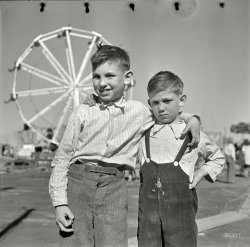
- Si Wa Wata Wa: 1903
- ... Americans.
Modern day battle I was recently in New Mexico and bought some turquoise jewelry from his granddaughter. At least ... Posted by Dave - 10/27/2019 - 3:22pm -
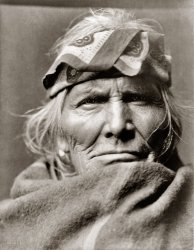
- Faro and Doris: 1940
- ... 1940. "Faro and Doris Caudill, homesteaders, Pie Town, New Mexico." Faro and Doris got divorced a couple years after this picture was ... Posted by Dave - 09/07/2011 - 3:59pm -
